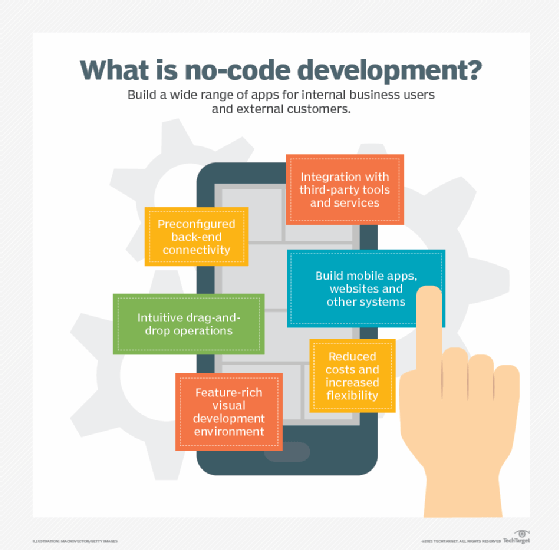Best Facts On Choosing Legacy application modernization with Low-code
Best Facts On Choosing Legacy application modernization with Low-code
Blog Article
Speed-WiseLow-Code Software Offers A Variety Of Advantages.
Visual Development Environment :
Drag-and-Drop Interfaces: Low-code platforms provide visual tools for designing applications. Drag-and-drop elements allow developers to quickly build applications, without needing to write code.
Pre-built components and templates A lot of low-code platforms include pre-built components and templates that allow developers to quickly prototype and build applications.
Reduced Coding Requirements for Coding:
Automated Generated Code: Lowcode platforms write the code base on the visual models created developers. This helps reduce manual code, and speeds the development process.
Reusable Components : Developers can reuse components from various projects to cut down on the amount of time needed to write and testing code.
A more efficient collaboration
Low-code development platforms are often equipped with tools such as deployment control, version control and testing. This allows for seamless collaboration between teams.
Citizen Development Developers, business users and other stakeholders are able to help in the creation of applications through user interfaces that are intuitive. This eliminates the bottleneck created by the inaccessibility of skilled developers.
Rapid Iteration, Prototyping
Rapid prototyping. Developers can design prototypes in a short time to validate their ideas as well as get feedback. This will lead to a more efficient iteration.
Easy Modifications: Low-code design is oriented towards visuals, which makes it easier to change and upgrade applications. It helps speed the process of improving and enhancing applications based on feedback from users.
Pre-built Integrations:
API Integrations: Low-code platforms are often pre-built with connectors to popular services and APIs. This cuts down on the time needed to connect external systems.
Data Integration: The tools integrated in the software make it easier and accelerate the process of connecting databases, other data sources and applications.
Deployment Scaling
One-Click Deployment: A lot of low-code platforms provide one-click deployment options, significantly reducing the time and effort needed to deploy applications.
Cloud-based solution: Cloud based low code platforms are able to handle the management of infrastructure and scale. This lets developers concentrate more on the application logic, functionality and features instead of deployment logistics.
Low-code application development is a more efficient method to develop applications. It simplifies and automates many elements of the procedure. This enables faster delivery and adaptation to the changing needs. Have a look at the most popular Low-code Platform for application development advice for more tips including develop web app, cloud software applications, rad development, application development platforms, push notifications, push notifications, low code platforms, ms azure sql, app platforms, develop cross platform mobile app and more.
The Advantages Of Developing Low-Code In Terms Of Flexibility, Scalability And Scalability
Low-code development offers numerous advantages in regards to scalability and flexibility that are essential for building applications that are flexible enough to scale and change with changing business requirements. These are the main advantages:
Cloud-Based Deployment: Many low-code applications are cloud-based, enabling applications to scale seamlessly with the underlying cloud infrastructure. This lets businesses handle the increased workload without having to manage servers.
Auto-Scaling: The auto-scaling feature allows you to automatically adjust resources in accordance with the demand. This guarantees the same performance even during peak hours, without any manual intervention.
Flexible Architecture:
Low-code platforms promote modular designs where components can independently be designed, assessed and adapted. This is a fantastic way to enhance flexibility. It can also be used to update and expand parts of an application without having to have the whole application affected.
Microservices Integrate: Microservices enable applications to grow and become flexible by allowing them to be built as a collection of interconnected services.
Customizable Solutions
Extensibility. Low-code platforms typically allow for custom coding or scripting. This enables developers to expand the functionality of the application beyond what is offered out of the package. This lets businesses meet their own unique requirements.
Third-Party Integrations: Integration with third-party APIs and services allows businesses to add additional functions to their software.
Agile Development and Deployment
Continuous Delivery and Deployment : Low-code platforms support agile methods enabling continuous integration, continuous delivery (CI/CD). This facilitates rapid deployment of new features and updates. Applications are then able to grow rapidly as a result of market trends and user feedback.
Iterative Development - The low-code model allows applications to be improved and scaled incrementally which lowers risk and allows for more controlled expansion.
Resource Optimization:
Efficient resource management: Low code platforms optimize resources by offering tools for monitoring and controlling application performance. This ensures resources are used efficiently and are easily scaled according to the needs of the user.
Load Balancing : The integrated load balancing feature distributes workloads equally across servers. This improves the system's capacity to handle high traffic, and ensures constant performance.
Global Reach:
Multi-Region Implementation: Low-code platforms can be used across many geographical regions. This enables companies to provide users with low latency internet access across the globe. This is important, especially when it comes to applications that have global users.
Localization Support The built-in support for language localization allows applications to easily adapt to various local languages and requirements, enhancing their flexibility in different markets.
Updates and maintenance
Simple Maintenance : Low-code applications with a modular and visual design simplify maintenance tasks. This allows updates and bug fixes be made quickly, with no extensive downtime.
Version Control Systems for Controlling Versions can assist you in managing updates, rollbacks and changes. They assure that the changes can be released in a safe manner and that previous versions is restored as needed.
Cost Efficiency:
Low Development Costs - Through cutting down on the amount of code required, low code platforms can lower development costs. This makes it possible to expand applications without increasing the development effort and expenditure.
Pay-As You-Go Models: Many low-code platforms provide flexible pricing models, including pay-as you-go that align costs to actual usage and growth, providing financial flexibility.
In the end, low-code application development provides businesses with the flexibility and capacity they require to create robust and flexible apps. These platforms offer quick and efficient responses to evolving needs, resource efficiency and constant improvements, which allows for applications to grow as a company. Take a look at the recommended Legacy application modernization with Low-code blog for site info including app platforms, push notifications, develop mobile application, azure sql server, application development platforms, rad development, build with docker, stored sql procedures, azure sql server, rapid application design and more.
Benefits Of Low Code Application Development In Terms Of Limitations And Customization
Low-code development is an approach that is balanced and offers significant advantages in terms of solving limitations and allowing customization. Here are a few of the main advantages.
The Challenge of Overcoming Complexity Barriers
Low-code platforms simplify development by providing pre-built templates and components. This allows quicker deployment and the development of more complex applications.
Guided Workflows: Many platforms have guided workflows as well as wizards to help developers navigate through complicated processes, reducing the likelihood of errors and making sure that the process is consistent.
Scalability Solutions:
Scalability is built in: Low-code platforms typically include features that enable scalable architecture. Applications can handle increased loads with minimal redevelopment.
Performance Monitoring: Integrated performance monitoring tools and optimization ensure applications are as efficient as they can be, no matter their scale.
Security and Compliance
Low-code platforms have built-in security options, such as security access control based on role as well as encryption and automated checks for conformity. These features address commonly-asked security issues.
Platforms regularly update their security and compliance measures to ensure that applications are secure against threats that change.
Customization Options:
Extensibility:
Custom Code Integration: Low-code platforms often permit the integration of custom code (e.g., JavaScript, Python), enabling developers to expand the capabilities beyond what is available in the standard features.
Custom Plugins and Moduls Developers can create custom plug-ins or modules that offer specific functions tailored to the unique requirements of a particular business.
APIs & Integration:
API Support: A full API support is provided to allow seamless integration and connection to external systems.
Third-Party Services : Low-code platform often provides pre-built connections for popular services provided by third-party providers which makes integration and customization simpler.
Flexible Design for UI/UX
User interfaces that can be customized: Developers are able to modify and design the user interfaces to satisfy specific branding requirements and usability needs, providing a tailored experience for users.
Responsive Design: Built-in responsive design capabilities ensure that applications can be customized for various sizes of screens and devices.
Business Logic Customization
Visual Workflow Builds Visual tools that permit customization of workflows and business rules, and also to create complex custom processes.
Conditional Logic & scripting: Platforms allow for the use of conditional logic and custom scripting for handling specific business rules.
Data Management:
Custom Data Models Developers have the ability to develop custom data models specifically for particular applications, tailoring data handling to specific business requirements.
Advanced Data Processing: Integration of advanced tools and capabilities to process data permits customizations to the way data is processed in an application.
Customisation and balancing limits:
Frameworks and Standards
Low-code platforms support the use of industry-standards and best practices. This results in applications of high-quality that are scalable and safe.
Governance Frameworks - Built-in governance systems make sure that any modifications do not compromise security, integrity or the observance of regulations.
Iterative Development:
Rapid prototyping: The ability to quickly test and prototype customizations ensures that developers can iterate based on user feedback improving the app to meet the needs of users.
Continuous Improvement: Platforms with low-code support for continuous improvement, allowing customization and enhancement as business needs change.
User Empowerment
Enabling Citizen Developers In giving non-developers the ability to personalize their apps using simple interfaces as well as low-code platforms, they boost the number of users who can enhance and customize applications.
Training and Support A lot of platforms provide comprehensive training and support to assist users with successful modifications that do not compromise the stability of the application, or its performance.
In general, low-code application development is a strong framework that can address the limitations and provide ample customization opportunities. This balance allows companies to build and maintain apps which are functional, tailored for their specific needs and meet the highest standards of quality, security, and scalability.